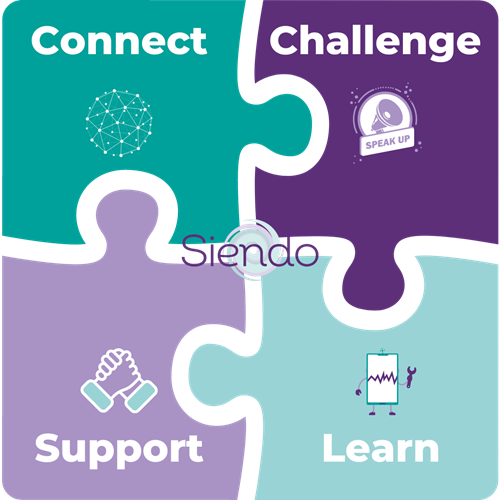4 ways to create psychological safety at work

In today's highly competitive and rapidly evolving business landscape, organisations are recognising the critical role that psychological safety plays in fostering a culture of engagement, collaboration, and innovation.
Gone are the days of stifled voices and unshared ideas. In this new era, creating an environment where employees feel safe, valued, and respected is paramount.
When we look at the low levels of employee engagement across the global workforce, it becomes evident that psychological safety extends far beyond the surface-level concept of feeling safe. Instead, it encompasses an environment where individuals are encouraged to express their ideas, take interpersonal risks, and engage in open and honest communication without fear of retribution or judgment.
Picture a workplace where individuals truly believe their thoughts and opinions matter; where speaking up, challenging norms, and sharing ideas are not only encouraged but celebrated. This is the essence of psychological safety—a catalyst that fuels creativity, ignites risk-taking, and fosters dynamic collaborations.
With this in mind, let’s take a quick look at the benefits of psychological safety and then explore how we can foster a workplace where innovation and productivity flourish.
The Benefits of Psychological Safety
From increased employee engagement and innovation to reduced turnover and improved wellbeing, psychological safety acts as the cornerstone of an incredible organisation, where individuals can truly thrive and contribute.
Here’s just five reasons why psychological safety should be top of your company agenda (also helping you to gain buy-in from the C-Suite).
1. Increased Innovation
When employees feel safe to share their ideas, they are more likely to come up with innovative solutions to problems. In a psychologically safe workplace, employees are encouraged to take risks and think outside the box, leading to new and creative ideas.
2. Higher Productivity
Low levels of psychological safety undermine productivity by inhibiting open communication, stifling risk-taking and innovation, and hampering collaboration. In a psychologically safe workplace, employees feel more motivated to work towards common goals, leading to increased productivity.
3. Greater Collaboration
Psychological safety is essential for fostering collaboration and teamwork. When individuals do not feel safe to share their perspectives or contribute to discussions, collaboration suffers. In a psychologically safe workplace, employees feel comfortable sharing their ideas and utilising the expertise of others, leading to better teamwork and collective problem-solving.
4. Improved Job Satisfaction
When employees feel safe and valued, they are more likely to be satisfied with their job and their employer. In a psychologically safe workplace, employees feel more connected to each other and are likely to stay with the company long-term.
5. Increased Employee Engagement
Low levels of psychological safety can lead to disengagement and reduced motivation among employees. A psychologically safe workplace creates an environment that encourages open communication, trust, collaboration, risk-taking, learning, and a sense of belonging. These factors significantly contribute to employee engagement by fostering a positive work environment where individuals feel valued, motivated, and empowered to contribute their best work.
Four Key Elements of Psychological Safety
So, we’ve established that boosting psychological safety is business critical, now what do we do about it?
Building a psychologically safe workplace demands collective effort to cultivate a culture that values connection, healthy challenge, holistic support and continued learning. Each element is instrumental in creating an environment where employees feel secure to express their thoughts and ideas.

1. Connect
Connection is focused upon building authentic relationships and creating a sense of community within the workplace. When people feel seen, heard, and valued, they are more likely to be engaged and productive, with far better levels of emotional and physical wellbeing.
To foster connection across the organisation, consider the following strategies:
- Interdepartmental connections: Create opportunities for employees from different departments to interact with one another. This can help break down silos and promote a sense of unity across the organisation.
- Regular one-to-one meetings: Provide opportunities for managers and supervisors to check in with their team members on a regular basis. Use these meetings to discuss both work-related and personal topics, and sometimes purely personal topics, so that you can create a culture of openness and support.
- Make employee feedback a workplace habit: There are so many ways we can glean feedback from our employees, that doesn’t just include lengthy, annual surveys. Encourage employees to provide regular feedback through various channels, such as pulse surveys, suggestion boxes, and one-to-one feedback sessions. Don’t forget to ensure transparency in the feedback process and demonstrate a genuine commitment to addressing employee concerns.
- Create intentional gatherings with a shared, clear purpose: Host events or meetings that have a specific focus or goal. Before planning a workplace gathering, clearly articulate the objectives, outcomes, and desired engagement levels. Purpose-driven gatherings can help promote meaningful conversations and build relationships across the organisation.
2. Challenge
Creating psychological safety means creating a culture where people feel safe to speak up and appropriately challenge the status quo.
To foster a culture of constructive challenge, consider the following strategies:
- Encourage diversity of thought and ideas: Invite your staff to share their opinions and perspectives, even if they differ from the majority and then celebrate constructive challenges and opinions.
- Constructive feedback is about the project, not the person: Emphasise the importance of providing feedback that focuses on the work, not the individual. This can help prevent personal attacks and promote a more productive dialogue.
- Be open to constructive feedback: Encourage your colleagues to provide feedback on your own work and be willing to hear the truth without becoming defensive.
- Speak up if team behaviour is not conducive to supporting friendly challenges: Take notice of any behaviours within the team that hinder constructive challenges, and proactively address the issue. It is common for individuals to need a little coaching on how to effectively manage friendly conflicts and provide feedback.
- Think smarter together: To truly "think smarter," it is essential that every individual in the room feels empowered to express their thoughts and ideas openly, without judgement. Cultivating an environment where every voice matters enables us to elevate our collective thinking.
3. Support
Adopting a culture of support is about creating an environment where employees feel safe and valued. If people do not feel psychologically safe, they will not reach out for support when they’re struggling and – as a result – we will experience far more incidences of poor mental health at work.
To foster a supportive workplace, consider the following strategies:
- Design all one-to-one meetings around creating safety: Psychological safety is not created overnight; it’s developed overtime through every single interaction. One-to-one meeting are an excellent place to nurture a safe space for employees to share their thoughts and concerns.
- Destigmatise Employee Assistance Programmes and the fluid nature of mental health: Encourage employees to seek help when they need it and provide resources and support to help them manage their mental health.
- Actively promote (and support) your Mental Health Champions & MHFAiders: If you’ve taken the initiative to train your staff in important mental health awareness skills, make sure to effectively utilise them to create culture where employees feel safe to discuss mental health and seek support when needed. MHFAiders, when used effectively, can be an incredible source of support, helping to relieve a vast amount of pressure placed on management and HR.
- Foster confident and engaged leadership: When leaders feel supported, empowered, and recognised, they are more likely to inspire and motivate their teams, driving overall organisational success.
- Optimise every element of your employee experience: Ensure that every stage of the employee experience is designed to promote psychological safety and support. Consistency is key.
4. Learn
Creating a culture of learning means creating an environment where people feel safe to try new things and make mistakes.
To promote a learning culture, consider the following strategies:
- Focus on solutions and how to avoid, not who is to blame: Encourage employees to focus on finding solutions to current problems, rather than assigning blame for past mistakes.
- Lead by example and own up to your mistakes: Model the behaviour you want to see in others by taking responsibility for your own mistakes. We’re all human.
- Destigmatise asking for help, by asking for help: When you lead by example and seek support when you need it, you take away the fear and shame for others. It’s not a shameful thing to ask for help - it takes courage and vulnerability to stop and say - “I’m not okay. Help me.”
- Make your thinking visible: Don’t assume those around you understand the reasons behind your decisions. Share your thought processes and decision-making journey with your team to help them understand how you arrived at your conclusions.
- It's okay to say you don't know: Encourage employees to acknowledge when they don't have the answer. It is not possible to have the answer to everything – that’s why we work as teams. We are stronger and smarter together.
Final thoughts
Creating a psychologically safe workplace requires a conscious effort to promote connections, challenge the status quo, provide support, and foster a culture of learning.
By implementing these strategies, you can create a positive and thriving work environment where employees feel safe to speak up, share their ideas and concerns, and work together to achieve common goals.
Remember, creating psychological safety is an ongoing process that requires continuous effort and attention. By making it a priority, you can maximise employee engagement and create a culture of trust and respect.
Your next steps
Find out more about Rebecca Reed, and the multitude of ways that Siendo can help you to build happy, healthy and high-performing cultures.

Rebecca Reed, Workplace Wellbeing & Mental Health Expert
- Email: hello@siendo.co.uk
- Website: https://www.siendo.co.uk/
- Book a call: https://calendly.com/hello_siendo/30min
- LinkedIn: https://www.linkedin.com/in/rebecca-reed-cheetham/
For more actionable tips and advice on how to improve staff wellbeing and reduce turnover, check out Siendo’s latest white paper: “Do your employees know you care? How to build an empathetic work culture, support employee wellbeing, and retain your organisation’s greatest assets: your people”.
Our HR Hubs
Rebecca Reed was a guest speaker at Allen Associates’ HR Hub – an online network of HR professionals, people managers and employers who meet monthly to hear from experts in their field.
Find out more and sign up to receive invitations to future HR Hubs.
Recruitment support
If you would like any help and support with your recruitment, please visit the Employers section of our website or contact us at hello@allen-associates.co.uk.
